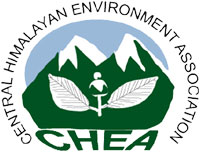"In the 21st century humankind will increasingly depend on mountain resources such as water, bio-diversity, and recreation." - Arnold Koller
The Central Himalayan Environment Association, CHEA in short, was founded on October 2, 1981, on a day which has special significance for India, being the birth-day of the Father of the Nation, Mohandas Karamchand Gandhi. The society was registered soon afterwards in May, 1982. Arguably CHEA is one of the earliest societies founded in Northern India which had ' the environment and the livelihood of the people in the Himalayas ' as its core concern.
Much water has flown in the great Himalayan rivers and the Indian Himalayas have since been witness to much distress, conflict, degradation, demographic dynamics, political restructuring and impacts of various global revolutions and their regional and local impacts. CHEA has since espoused many mountain causes, engaged itself actively in scores of action-researches on human and environmental aspects and livelihood-related projects and continues to be so involved to this day.
Since the Rio Earth Summit in 1992 with the inclusion of Chapter 13- 'Managing Fragile Ecosystems : Sustainable Mountain Development' in the UN Conference on Environment and Development (UNCED) the importance of mountain social-ecological systems have been acknowledged for the first time on a global scale. Establishment of CHEA, let it be recalled, pre-dated the Rio Summit by more than a full decade. Certainly the perceptions of a seminar organised in October 1983 by CHEA in participation of academicians, activists and scientist to se the future course of action for the Indian Himalayas has to be re-evaluated in context of the insights the world at large and the Indian sub-continent in particular has gained and with which CHEA has a re-alignment of its strategy for the 21st century, both in context of local and global priorities. To ensure solution of increasing pressure on natural resource for rural livelihoods CHEA has developed strategies for stregthaning grassroots environmental governance and undertaking action research.
Ensure the development of prosperous and secure mountain communities that are peaceful, equitable, and environmentally sustainable.
Our mission is to integrate rural livelihoods and sustainable conservation practices to reduce the environmental, economic, and social vulnerabilities of the mountain people. In cooperation with regional and international partners, and working with the communities, we aim to develop and provide integrated and innovative solutions that guide policy change and inspire action to directly benefit the mountain people and their environments. The Himalayas are the principal home of glaciers and the source of water for over 1 billion people living in connected river basins. They are also extremely vulnerable to climate change. Thus, there is a critical need to guide development that incorporates and is compatible with the threat of a changing climate.

The leaf of the oak tree is our emblem, the species occupies nearly 20,000 sq km area in Uttarakhand between 1000-3000 m elevation. The oak forests are associated with water, humidity, biodiversity and life in general in the hills. It is the tree of masses and is the lifeline of village communities. The fresh new oak leaves are a useful source of fodder. The acorns are a favourite food for some species of wild life. The emblem implies catering to the livelihood and sustainable needs of the hill communities and wildlife of the region.
The area of activity of the Association is the Himalaya and adjacent areas in general, and Kumaun and Garhwal Himalayan regions in particular.
Creating the environment to help Himalayan village communities to protect and enrich their environment and to contribute to addressing regional and global issues by exploring all positive linkages between environmental conservation and economic growth.